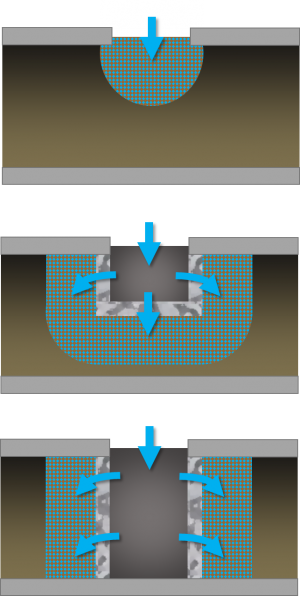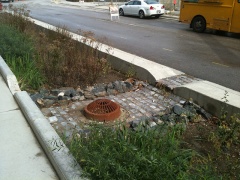Difference between revisions of "Pretreatment features"
Jenny Hill (talk | contribs) |
Jenny Hill (talk | contribs) |
||
| Line 1: | Line 1: | ||
[[File:Forebays.png|thumb|Without a forebay (top) the flow is concentrated around the inlet, potentially causing erosion and not optimally spread for infiltration; A three sided forebay (centre) with a level spreader on all sides will distribute the water and reduce the energy, sediment will collect in the pad of the forebay (shown darker); In a narrow cell, the forebay may extend across the whole facility (bottom).]] | [[File:Forebays.png|thumb|Without a forebay (top) the flow is concentrated around the inlet, potentially causing erosion and not optimally spread for infiltration; A three sided forebay (centre) with a level spreader on all sides will distribute the water and reduce the energy, sediment will collect in the pad of the forebay (shown darker); In a narrow cell, the forebay may extend across the whole facility (bottom).]] | ||
| − | Forebays are a form of pretreatment for open inlets. Energy of the incoming flow is dissipated, causing suspended particles to drop out of the water. These accumulated particles/sediment can then be easily swept or vacuumed during routine maintenance and doesn't end up clogging downstream filter media or material. | + | Forebays are a form of pretreatment for open inlets. Energy of the incoming flow is dissipated, causing suspended particles to drop out of the water. These accumulated particles/sediment can then be easily swept or vacuumed during routine maintenance and doesn't end up clogging downstream filter media or material. <br> |
| − | A well designed forebay will also spread the flow somewhat, reducing erosion around the inlet. One effective way of achieving this is by surrounding the pad with some level spreader on all sides. The level spreading could | + | A well designed forebay will also spread the flow somewhat, reducing erosion around the inlet. One effective way of achieving this is by surrounding the pad with some form of level spreader on all sides. The level spreading could be a sharp crested weir in metal or concrete, or be more like a soft edged, rocky check dam. |
<Gallery mode="packed"> | <Gallery mode="packed"> | ||
Forebay AV.jpg|Forebay connected to drainage area in the roadway with a curb cut, overflow visible in the centre of forebay area, level spreading is encouraged with the rock check dams, Milwaukee, WI,[[Acknowledgements| Photo credit: Aaron Volkening]] | Forebay AV.jpg|Forebay connected to drainage area in the roadway with a curb cut, overflow visible in the centre of forebay area, level spreading is encouraged with the rock check dams, Milwaukee, WI,[[Acknowledgements| Photo credit: Aaron Volkening]] | ||
</gallery> | </gallery> | ||
[[Category:Pretreatment]] | [[Category:Pretreatment]] | ||
Revision as of 02:21, 15 August 2017

Forebays are a form of pretreatment for open inlets. Energy of the incoming flow is dissipated, causing suspended particles to drop out of the water. These accumulated particles/sediment can then be easily swept or vacuumed during routine maintenance and doesn't end up clogging downstream filter media or material.
A well designed forebay will also spread the flow somewhat, reducing erosion around the inlet. One effective way of achieving this is by surrounding the pad with some form of level spreader on all sides. The level spreading could be a sharp crested weir in metal or concrete, or be more like a soft edged, rocky check dam.
Forebay connected to drainage area in the roadway with a curb cut, overflow visible in the centre of forebay area, level spreading is encouraged with the rock check dams, Milwaukee, WI, Photo credit: Aaron Volkening
